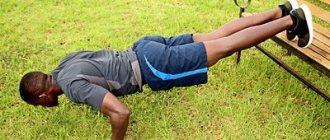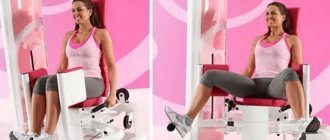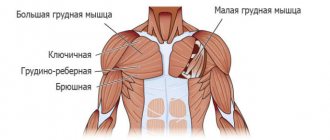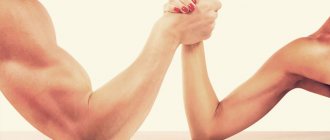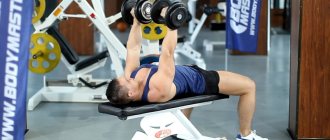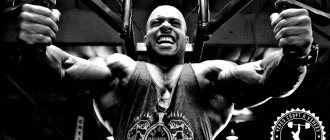The material was prepared by the site team with the support of our experts: athletes, coaches and nutrition specialists. Our team >>
- Reading time: 5 min.
- Which exercise machine should I use?
- Seated press machine
- Hummer Seated Press
- Seated press and Smith machine
- Seated Angle Press
- Seated Vertical Press
- How to best combine exercises
We recommend reading: A set of abdominal exercises at home
The bench press is a universal exercise that can be used to pump up the upper and middle part of the chest, shoulders, and triceps. On the one hand, this is an imitation of a bench press, on the other hand, a barbell press at different angles and even a seated dumbbell press. And all this is possible thanks to the variety of seated press machines (from the Hammer to the Smith).
Exercises
All chest muscles can be roughly divided into three parts - upper, middle and lower. Each part is better stimulated depending on the change in angle at which you perform the exercise.
- For the upper part, exercises performed on a bench at an upward angle of 30-45% are best suited.
- For the middle part, exercises performed on a flat bench are best.
- For the lower part, exercises performed on a bench at a downward angle of 30-45% are best suited.
All chest exercises must be performed with perfect form because poor form can become a habit that will lead to lack of progress or worse, injury in the future. The following are exercises you can do to train your chest muscles, and a step-by-step guide will help you achieve perfect technique.
Exercises for the shoulder girdle
Vertical presses of barbells and dumbbells. I recommend doing the barbell press only from the chest, since if you perform the barbell press from behind your head, then your shoulder joints are not in a very good physiological position.
Of course, nothing will happen right away, but if you continue to do bench presses from behind your head, the negative consequences will accumulate, your shoulders will begin to “ache,” and in the end you will either quit the sport or an injury will stop you.
Dumbbell presses are more beneficial for the shoulder joints, both from the point of view of the load on the anterior and middle deltoid muscles, and from the point of view of the health of the shoulder joints.
Dumbbell presses can be performed by squeezing the dumbbells together, you can take turns, or you can even do a press with one hand.
Seated bench press
There are various options for simulators for performing this exercise. However, absolutely all of them are designed to work the pectoral muscles. The trajectory of movement that the machine sets allows you to focus on the target muscle group while minimizing the involvement of the shoulder muscles.
The horizontal bench press allows you to work the muscles from different angles compared to the standard vertical bench press. Some exercise machines allow you to adjust the seat height, which allows you to shift the emphasis to the upper or lower part.
Technique:
- Get on the machine and choose the weight that's right for you. Hold the handles of the machine with your palms facing down and raise your elbows so that your upper arms are parallel to the floor. Push the handles forward and extend your arms. This is the starting position.
- As you inhale, pull the handles of the exercise machine towards you. As you exhale, push them away from you. Hold the squeeze for a second before returning to the starting position. Try to keep your shoulders and back on the bench.
- Do the recommended number of repetitions. Slowly return the handles to place when you finish your set.
Do 3 sets of 10-12 reps, resting 45 seconds between sets.
Which exercise machine should I use?
Let us explain that the choice of a simulator (or let us agree that we will henceforth talk about the angles of the force vector relative to the floor) depends on what muscles you want to pump.
We recommend reading: How to pump up abs in a month for a man
In this article we will take an overview of the most important techniques in various simulators:
- To pump up your chest, you need to choose a machine that simulates a bench press. Usually this is a device with a seat and a backrest at right angles to it. The handles that will need to be pushed away from you (press) are located at the level of the bottom of the chest. The exercise is more similar to a reverse grip press, although the palms are in a straight position.
- To work the shoulders you will need a hammer and a Smith machine. In a Hummer you can pump up the front deltoids. This is a good option after the classic bench press and incline press.
- In Smith, you can do presses at different angles, as well as a seated barbell press (when you press it vertically up, bringing it behind your head or onto your chest).
Thus, the choice of a simulator will directly depend on what you want to train today. And, of course, it depends on what kind of exercise equipment is available in the gym you come to.
Seated Angle Press
This exercise is almost identical to the classic bench press in a seated machine. However, the machine in which it is performed has an incline bench, which allows you to better focus on the upper part of the pectoral muscles.
Technique:
- Start by adjusting the seat of the bench so that the arms of the machine are in line with your upper chest. Also set the appropriate load. Sit on a bench and grab your hands. This will be your starting position.
- As you inhale, begin to slowly push the handles of the machine forward until your arms are fully extended. You should feel a stretch in your pectoral muscles. Hold this position for a couple of seconds and then slowly return to the starting position.
- Do the recommended number of repetitions.
Seated bench presses on the pectoral muscles will allow you to effectively work out your muscles. Do 3 sets of 10-12 reps, resting 45 seconds between sets.
Corner push-ups
At home, on vacation or on a business trip, you can perform reverse presses in the form of reverse push-ups or corner push-ups. If you find it easy to do them on the floor, then place your feet on a bench.
I do not present a more complex type of handstand push-ups, since there are even few men in the world who can do them. Plus, in a handstand, intracranial pressure increases very strongly, which becomes even greater if we start doing push-ups.
It's one thing to want to do handstand push-ups, but it's another thing to do push-ups, which can be dangerous, especially if you have poor eyesight. Then the increased pressure can do a disservice to both your eyes and the blood vessels of your head.
Smith machine chest press
This exercise is perfect for beginner athletes who are just learning to feel their muscles. The bench press with free weights allows you to move through a greater range of motion, but it is not as safe. The Smith machine has hooks that you can use to secure the barbell if you feel like you can't complete a rep.
If you are new to this exercise, ask a trainer or friend to guide you. If this is not possible, then do not lift heavy weights to avoid injury.
Technique:
- Place a flat bench under the machine. Then set the barbell to such a height that you can reach it with straight arms from a lying position. Once you have established a weight that suits you, lie down on a flat bench. Place your hands on the barbell at a shoulder-width distance apart, using a pronated grip. Remove the bar from its safety catches and hold it straight above you with your arms extended. This will be your starting position.
- As you inhale, gradually lower the barbell until it rests on your mid-chest. As you exhale, after a short pause, return the barbell back to its original position. Hold at the top for a second, and then begin to slowly lower the barbell down again.
- Do the recommended number of repetitions. When you're done, lock the barbell into the machine.
Do 3 sets of 10-12 reps, resting 45 seconds between sets.
Hummer Seated Press
The hammer simulates a barbell or dumbbell press at different angles, usually 45 and 60 degrees. This machine will help you pump up your upper chest and front deltoids.
It has a device (pedal) for bringing the weight to the starting position. Use light weights for warming up.
- Adjust the seat height so that in the initial position the handles of the hummer are at the level of your shoulders, and your arms do not “twist” back. If the seat is too low, your elbows will be extremely far back. It is very difficult to start a repetition from such a position.
- Help lift the weight with your foot by pressing the special pedal.
- After the handles have returned to the starting position, squeeze them out with your hands (you don’t have to straighten your arms completely so that the elbow joints don’t snap into place - leave a slight angle between the forearm and shoulder).
- Lower the weight back to a physiologically comfortable position. Repeat this movement 10-15 times – the warm-up is complete. As you climb, don’t forget to exhale through your mouth. Inhale through your nose while lowering the weight.
- Help lower the weight to its original position using a special pedal.
Set the working weight and do 8-10 repetitions in 3-4 sets.
Hand curls in the simulator
To train your chest, it is important to combine two types of movements: compression and deep stretching. The hand pinch machine helps you do both of these. The butterfly exercise (peck-deck) is an isolating exercise that allows you to strongly compress the chest muscles and then stretch them in a negative phase.
Technique:
- Set the weight that suits you. Your shoulders should be parallel to the floor, so adjust the machine accordingly. Sit with your back resting on the exercise pad. Take your pens. This will be your starting position.
- As you exhale, slowly begin to bring your arms together, squeezing your chest muscles. Hold the contraction for a second at the peak point. As you inhale, return under control to the starting position until your pectoral muscles are fully stretched.
- Do the recommended number of repetitions.
A good training option would be to combine hand presses in a machine with push-ups. Once you complete 20 reps, move on to 20 push-ups. Perform 3 supersets in this manner, taking a 60-second break between exercises.
How to do the exercise correctly?
To get the most out of it and make the chest press in the machine truly effective, follow the following algorithm:
- choose the load that is most suitable for your muscles. Many people immediately set the weight with which they work for the classic bench press. This is a mistake, because in this exercise slightly different muscles are involved, so doing the exercise will be more difficult. The ideal option is when, with a set load, you can perform ten repetitions;
- adjust the seat height. Please note that a high seating position will result in increased stress on the lower areas of the pectoral muscles. This is explained by a change in the position of the hands in relation to the body. Lowering the seat height, on the contrary, places the emphasis on the upper chest muscles. Once the seat is set, sit down, press completely against the supportive backrest and rest your head against it;
- If the machine has an auxiliary pedal, press it to make it easier to move the handles a little forward. Lower your legs to the floor and fix them tightly, your hands should tightly grip the handle;
- start the movement from the bottom position (arms are in a spread position). As you press the weight up, your hands will gradually move closer to each other. Next, continue pressing the weight until your limbs are completely straightened. At maximum straightening, look at where your hands are - they should be in front of your chest and as close to each other as possible (without touching);
- lower the weight by raising your arms to the sides. Stop when your fists are level with your chest. In this situation, you provide maximum amplitude and fully load the chest muscles without undue risk to the shoulder joints;
- exhale as you straighten your arms and inhale before lifting the load up;
- complete all repetitions without delay. Upon completion of the approach, press the pedal, smoothly return the machine to the starting position and remove your hands from the handles.
The seated press works both parts of the large chest muscles well, so controlling the weight is essential. Achieve maximum muscle stretch in the bottom position. Avoid partial range of arm movements, which will be ineffective and will not give the expected result.
The peculiarity of the seated press is that when raising the arms, the latter gradually converge towards each other. This, in turn, puts additional stress on the inner chest muscles. In addition, at the final stage of lifting, the triceps are included in the work, which leads to gradual fatigue from the workout.
Mistakes in training the pectoral muscles
The two biggest mistakes most people make in their training are:
- Focusing on the wrong exercises. Many people pay excessive attention to machines and isolation exercises, which have a secondary role in creating impressive muscle mass in the chest muscles.
- Lots of repetitions. Repeated training will only tone the muscles, but not build them.
The more you perform compound movements with heavier weights (80-85% of your maximum and above), the better your results will be.
